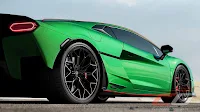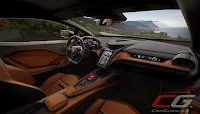Lamborghini has finally revealed the replacement to its Huracan after 11 long years: the Temerario. With the arrival of the Temerario to the house of the raging bull, it now means the entirety of the Lamborghini line-up is now electrified (or available with an electrified powertrain).
Previewed before the Temerario’s launch, the powertrain ditches the Huracan’s normally-aspirated V10 engine in favor of a 4.0-liter twin turbo V8. Though one might think it’s related to the Urus’s V8, it’s not. The new L411 engine is different in that it has a flat-plane crankshaft, titanium conrods, and a finger-follower valvetrain with a diamond-like carbon coating to sustain high revs. True enough, it spins to a mind-boggling 10,000 rpm.
The ICE alone makes impressive numbers: 800 horsepower and 730 Nm of torque, but add to that a three-motor system—each one producing 150 horsepower—and the total system output climbs up to 920 horsepower. Lamborghini says the new engine maintains the smoothness and linearity of the Huracan’s V10 while delivering the high power and torque figures typically associated with a turbocharged engine. Coupled with a new eight-speed dual-clutch, the Temerario hits the 100 km/h mark in just 2.7 seconds. Top speed? 343 km/h.
Interestingly, the electric motors are powered by a 3.8-kWh battery allowing the Temerario to run on its front motors (yes, it becomes a front driver in this instance) up to 190 horsepower. It can be charged using a 7-kW wall box (AC only), taking just 30 minutes for a full charge.
Drivers can also precisely control the Temerario’s powertrain via several modes including one that recharges the battery (Recharge). There are also modes designed for the city (Citta), street (Strada), Sport, Corsa (race), and Corsa Plus (race + all driving aids off). Only in Cita mode can the Temerario be driven on electric power alone; all other settings always engage the V8. You also get launch control and a Drift Mode with four levels.
The powertrain is fitted onto a new aluminum spaceframe chassis with more room than ever before (for helmets say Lamborghini). Furthermore, it also optimizes weight and reduces complexity. It’s also 20 percent more rigid than the Huracan’s. All in all, curb weight is up 268 kilograms over the Huracan. Further ensuring optimized grip and handling, Lamborghi called up Bridgestone to come up with a full range of customized tires (including winter tires) sized 20s at the front and 21s at the back. Carbon ceramic disc brakes are standard with 10 pistons and a 410-mm caliper upfront.
In terms of design, the Temerario features hexagonal shapes all around. The sharp, angular silhouette though is still characteristic of Lamborghinis with its low-slung look and slim, swooping glass area. From the side, it does have whiffs of the Gallardo to it, but a fixed rear spoiler adds visual width. Designers have paid close attention to aerodynamics with solutions including hollow DRLs which direct air through the front of the car. There are various fins (even on the door mirrors) to help channel air effectively. All in all, Lamborghini says it delivers a 103 percent increase in downforce versus the Huracan.
For even greater downforce, there’s the Alleggerita (lightweight) pack, adding a finned carbon fiber front splitter along with carbon underbody panels, side skirts, rear engine cover, and even wheels. A lightweight glass rear window and polycarbonate front and rear three-quarter windows are also fitted. There’s also a more aggressive rear spoiler, carbon fiber door cards, and passenger foot rest. Opting for this reduces the weight by 25 kilograms, while increasing downforce by 158 percent versus the Huracan.
The interior of the Temerario is very similar to the Revuelto’s, incorporating a Y-shaped center console, hexagonal corner air-con vents, and a trio of screens. The latter includes a customizable 12.3-inch digital instrument display, an 8.4-inch portrait infotainment touchscreen, and a 9.1-inch passenger display.
On the center screen, users are able to customize the layout of the hexagonal interface and swipe contents towards the driver and passenger screens. You also get wireless Apple CarPlay and Android Auto and a Sonus Faber sound system.
The Temerario also debuts a Lamborghini Vision Unit: a brace of three cameras that captures the forward view, the front cabin, and the occupants. This not only functions as a dash cam but also integrates into the Lamborghini Telemetry 2.0 system, which features over 150 circuits around the world. You can also record up to two minutes of driving footage using the Memories Recorder function.
The rest of the cabin has been designed to make the driver feel like a pilot. They sit on 18-inch power-adjustable comfort seats with heating and ventilation (carbon fiber sports seats are optional) and face a flat-bottomed steering wheel with driver controls all placed on the wheels itself. On the center console, there’s the starter button underneath a flip-up cover and a push-button gear selector with a distinctive toggle for reverse.





















Although they already have the Urus crossover SUV, why can't Lamborghini build sedan-based front-engine, front-wheel drive (FF) layout crossovers just as Porsche, Ferrari and Koenigsegg would? Lotus already did one anyway...
ReplyDelete